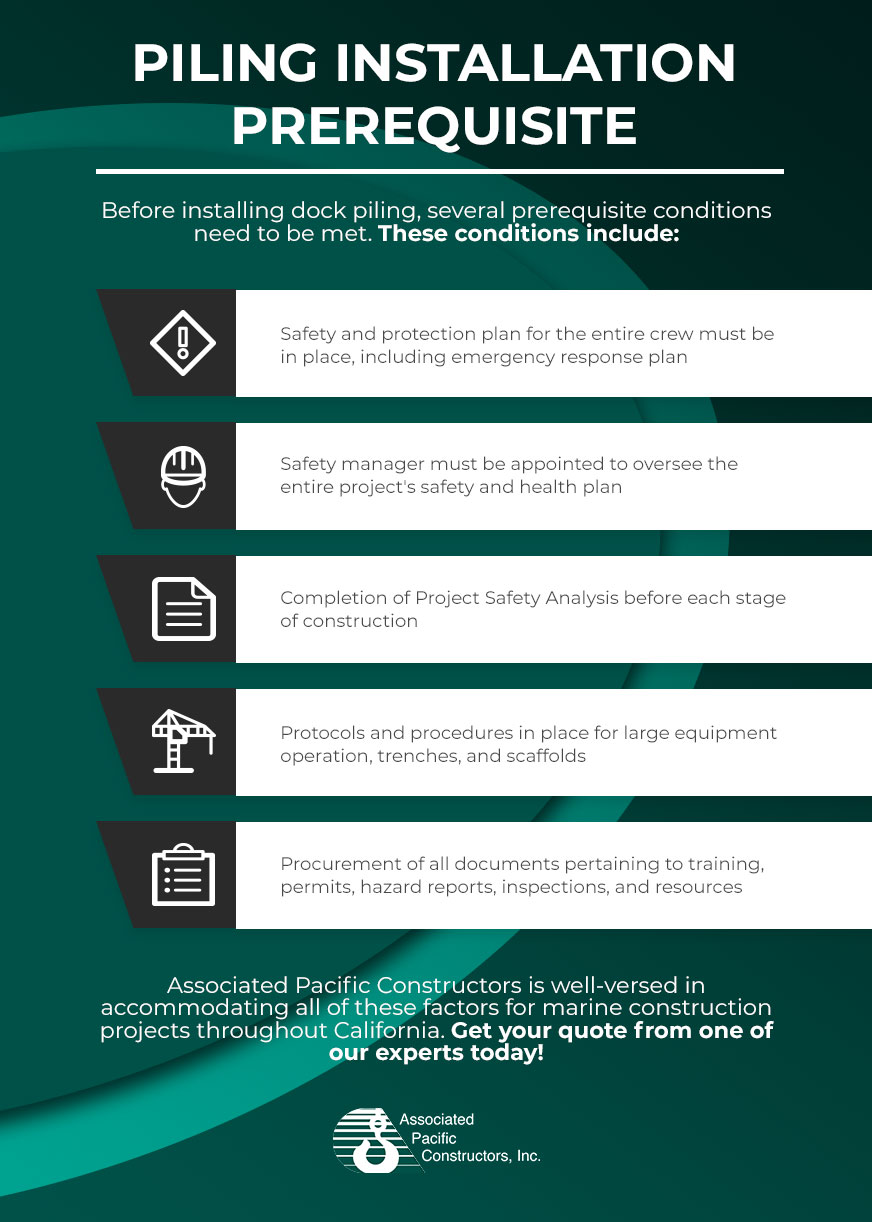Marine Pile Driving 101
Marine pile driving, a fundamental aspect of marine construction, is vital to the quality of the end result of many construction projects along waterfronts. The potential for something to go wrong while installing dock pilings is higher at this stage of construction than any other aspect. You have to accommodate factors like the piling rig, a 50,000 lb. pile hammer, and piles of varying lengths. In addition to the sheer scale of the project, you’ll have steel casings in excess of 60 ft. being moved by a crane, all on a floating barge. The point is this — this is no job for amateurs.
Prerequisite Factors Prior to Installing Dock Pilings
Proficiency and professionalism are key to constructing any marine structure, and installing dock pilings is no exception. There are several factors that need to be addressed to complete the job safely and within strict safety guidelines, all of which APC is well-versed in accommodating. Here are just a few of those factors that need consideration prior to a pile installation:
- The protection and safety of the entire crew are paramount — have all necessary procedures been put in place to assure this is taken care of?
- Has a manager been appointed to oversee the project safety and health plan of the operation, and is this person able to accurately ascertain hazards that are present? Have they been given proper authority to take corrective actions?
- Has a Project Safety Analysis been completed before each stage of the building process?
- What resources are in place to provide any subcontractors the help they need to be comfortable with the marine build project plan?
- What protocols and procedures have been implemented to oversee operations of cranes, barges, and pile drivers?
- What protocols and procedures have been implemented to oversee the construction of structures like trenches and scaffolding?
- What protocols and procedures have been implemented to oversee operations like welding, cutting, hoisting, and moving of hazardous materials?
- Are all documents relating to training, permits, hazard reports, inspections, and related resources available and accounted for?
- Has an emergency response plan been created?
Worksite Analysis
The purpose of participating in a pile-driving worksite analysis is to identify both existing and potential hazards that could arise. This analysis should include a comprehensive survey of the worksite for safety, updated surveys, analyzing any existing and potential future facilities, materials and equipment, and providing systems that allow employees to easily notify management members of potential hazards. Additionally, overseers should thoroughly investigate any accidents to identify their cause and create a prevention plan, including analyzing injuries and illness in order to prevent recurrences.
Dock Pile Driving Method
In conjunction with making adequate safety preparations for pile driving, the method of pile driving being utilized should be determined. Here are some of the most common methods that are used in the field today:
Drop Hammer Method
This technique for pile-driving uses the same principle as a hammer driving in a nail — only on a much larger scale. The hammer that is being used to drive the piles needs to weigh as much as the pile, and after being raised to an appropriate height, it is released within a guiding system to strike the pile. Essentially, it is a giant hammer and a giant nail. Within the spectrum of drop hammer methods, there are two types: single-acting, compressed-air hammers and double-acting pile hammers.
Single-acting hammers utilized a large weight inside of a cylinder, which is raised or lowered with compressed air or steam. When the weight reaches the necessary height, the air or steam is cut off, and the weight falls, driving the pile.
Double-acting hammers can likewise be driven by compressed steam or air. The difference is that a piling frame isn’t required with this setup. Rather, this hammer is attached to the top of the piles via leg-guides, with the pile being guided by a timber frame. This hammering method is very commonly used when installing sheet piles.
Vibrating Pile Method
In simple terms, when pile-driving via vibration, you’re essentially wiggling piles into place vigorously. This method is usually utilized on sandy or gravelly soil. These vibrating hammers are electrically or hydraulically powered and are made up of contra-rotating eccentric masses within a housing that is attached to the piling. The vibration caused by these off-centered masses, which rotate opposite each other, breaks down the surface tension on the sides of the piling, making it sink into the soil.
Pile Driving Services in California
With more than 40 years of serving the Southern and Central coast regions of California, Associated Pacific Constructors is your one-stop resource for all marine construction needs. In addition to being able to handle installation, we have expertise in managing the entire process, including any permitting that is required by the state. Contact us today for all of your pile driving needs! Our installation services include:
- Piers and wharfs
- Platforms and walkway foundations
- Dock guide piles, T-Piles, and Sea Flex anchoring systems
- Batter piling, Drilled, cased, and CID marine piles
- Secant piling


